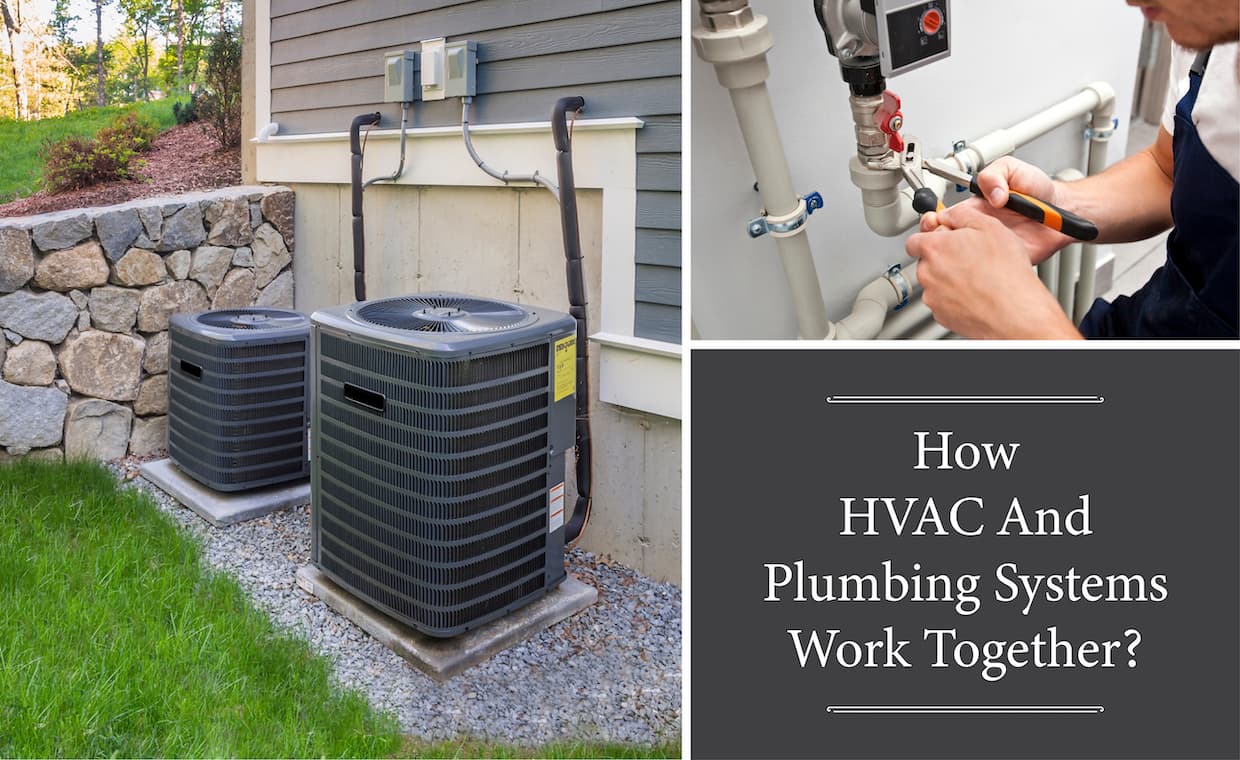
The HVAC and plumbing systems are essential components in any home because they help ensure water, humidity, and moisture are well contained. This role shouldn’t be overlooked because the presence of moisture in your home, especially if you live in a region with high humidity, can lead to mold and mildew. It also can cause extensive damage to your home, which is the last thing you want as a homeowner. Therefore, cleaning such systems, like drains, HVAC and plumbing, becomes necessary. In addition, if you hire an expert like Dallas drain cleaning, it will ease your hustle.
But are the plumbing and HVAC systems connected? This is a question you must ask yourself as a homeowner to help you maintain your home. And the answer to this is yes, the HVAC and plumbing systems are connected, even though this might not be that obvious. Continue reading this guide by an expert at Hy-Pro Plumbing & Drain Cleaning to get a complete picture of how the HVAC and plumbing systems are connected. Let’s get started.
How are the HVAC and Plumbing Systems Connected?
Before you find out how the plumbing and HVAC system are connected, it’s best first to learn the roles of each in your home. The plumbing system, which comprises pipes running across your home, with two primary purposes, and these are:
- Deliver fresh water into your home.
- Disposal of wastewater outside of your home.
This means the plumbing system is what allows you to maintain proper hygiene in your home by allowing you to do duties such as washing, food preparation, watering your lawn, and bathing.
In contrast, the HVAC, an acronym for heating, ventilation, and air conditioning, is a system tasked with heating and cooling your home or commercial building. This makes it an ideal addition to your commercial or residential building if you live in an area with varying climatic conditions, for instance, an extremely hot summer or very chilly winter.
The HVAC also helps improve your home’s air quality by removing odors, airborne bacteria, smoke, moisture, heat, carbon dioxide, and other gasses. It’s also responsible for properly ventilating your home through oxygen replenishment and temperature control. The HVAC system can effectively do all this thanks to specific integral components, including:
- Thermostat: This is the brain and nerve center of your HVAC unit, so it deservedly needs to be mentioned first. The thermostat works like the thermometer connected to the cooling and heating components, which come in handy when the air conditioner and furnace are switched on. Modern thermostats feature an interactive interface that allows you to program specific temperatures for a particular time of day, depending on the season.
- Air filter: It’s a fine mesh filter that cleans the air before it enters your home to enhance indoor air quality by removing all traces of dander, pollen, mold spores, and any other tiny particles.
- Compressor: This outdoor component converts refrigerant from liquid to gas and then sends this pressurized gas to the coils.
- Refrigerator lines: These are cold and heat-resistant metal tubes which move the refrigerant from the compressor to the evaporator coil. They must be in excellent condition to ensure the refrigerant reaches the condensing unit while it’s vaporized gas.
- Heat exchanger: This component sucks in cold air, heats it, and then circulates it throughout your home, and in the process, transfers heat from the hotter to colder parts of the HVAC unit.
- Condensing unit: This is the metal component that’s typically placed outside the home and is used for getting rid of the heat that’s accumulated indoors to the outdoors. It does this before the refrigerant passes through the evaporator coil to absorb more heat and cool down your home.
- Vents: This is the system of ducts passing through the entire home through which the cool or warm air passes.
- Ductwork: This system of ducts passes through the entire home through which the cool or warm air passes. Most ducts are made of aluminum due to their ability to handle temperature fluctuations, durability, and lightweight build.
- Furnace: It’s one of the biggest components of the HVAC unit and is tasked with moving air into the air ducts from the heat exchanger. The fuel source can either be oil, natural gas, or electricity that heats the air, which is then conveyed throughout the HVAC system.
- Vents: These are the parts through which the heated or cooled air enters your home and are usually rectangular in shape. They’re positioned on the floor or ceiling and have slots through which the heated or cooled air passes.
Since you now understand the roles of these two systems, let’s proceed to answer the question of how these two are connected. However, it’s essential to note that the HVAC and plumbing systems aren’t always connected in certain homes with different layouts. In such instances, an issue with either the HVAC or plumbing system won’t, in turn, affect the other system.
With that said, today’s modern home comes with a different layout, where the HVAC and plumbing systems are interlinked. This interaction usually happens at the point where the drain line of the HVAC system channels the condensation produced during the process of cooling your home into the main sewer line. Consequently, this condensation is directed through the sewer line, which constitutes the plumbing system to the exterior of your home.
Because of this connection, any issue with your home’s plumbing system could eventually find its way into the HVAC unit. This happens when an issue develops in the sewer line, which causes the backup of condensation into the drain line of your home’s HVAC system. As a result, this prevents the moisture collected in the HVAC unit from emptying into the sewer line, thereby causing water damage to the attic areas, floor, or ceilings.
In addition, the condensation, which is essentially water, could cause mold or mildew, which is expensive to repair and exposes you and your family to possible health issues. Another problem that might come up is damage to the drainage line itself, or at the point it’s connected to the sewer, which then starts to leak.
Some effective ways you can pinpoint where the leak is to reduce damage to your home include:
- Inspect if the plumbing fixtures have rust or signs of dampness.
- Examine whether your floor is lying flat or warping.
- Check your water bill to see if it’s higher than usual.
- Listen for dripping sounds and try to locate where it’s coming from.
- Look for stains in the ceilings, carpets, and walls, and more so around toilets, faucets, and appliances.
- Examine for an unexplained musty smell or new dampness.
By following any of these approaches, you can be able to solve other issues, such as how to stop musty smell from air conditioner.
What are the Additional Plumbing and HVAC Issues You Should be Aware of?
There are also other additional HVAC and plumbing issues that you need to know about and here’s a look at some of them:
01. Cracking, Rupturing, or Broken Joints Of The Condensation Line

One issue with the HVAC and plumbing system is problems with the condensation line, which is usually built from Poly Vinyl Chloride (PVC) tubing. The condensate line is similar to your home’s water supply which is part of the plumbing system that passes through walls and ceilings. This exposes the condensation line to possible problems such as broken joints, rupturing, and cracking.
02. Damage To The Ceilings, Walls, and Flooring

Another problem you should know about is that the condensation line could damage the ceilings, walls, and flooring. This happens because there isn’t too much pressure in the condensation line, as is the case with water-supply lines. As a result, water slowly leaks from the condensation line at the cracked point.
You can luckily address issues with the condensation line by hiring a qualified plumber. Hiring this professional instead of an HVAC expert is advised because they’re knowledgeable and experienced in how to deal with PVC tubing.
How Can You Best Maintain Your HVAC Condensate Drain?
As you probably know, prevention is better than cure, which is why routine maintenance of the HVAC and plumbing systems is advised to prevent avoidable issues. Here’s a look at some helpful tips on how to maintain these two systems;
01. Inspect The Condensate Drain On Your Home’s Exterior

One of the best ways to prevent any issues with your HVAC and plumbing system is by properly maintaining the condensate drain. You should do this by examining at what point the condensate drain exits in your home. Ideally, there should be a drip on the condensate drain each time you switch on the HVAC unit. This is a clear enough sign that the air conditioner is effectively working at extracting moisture from the air in your residential or commercial premises.
If you don’t see any drips even while the HVAC unit is turned on, this is a sign that there might be a blockage in the system. Here’s a look at some of the things you can do to resolve the issue:
- Check Your HVAC Unit’s Condensate Drain Pan
If there’s water in the condensate drain pan, this is a clear enough sign of a blocked drain. This issue is best resolved by calling a certified HVAC technician, but you can also do it yourself.
If you see any signs of rust in the condensate drain pan, this is a symptom of a bigger problem that can’t be resolved with a ceiling saver or float switch. You can best prevent such rusting in the future by installing a rustproof drain pan that’s more study and resilient to rust.
- Install A Float Switch
Another way to resolve an issue with the condensate drain is by installing a ceiling saver, also known as the float switch. These switches are very convenient in the event the drain pans are filled up or when the drain blocks and you wish to switch off your air conditioner.
Before you install a float switch, you should consult a certified HVAC contractor to pinpoint the location of the drain. After that, you can gauge the benefits of installing a drain pan float switch.
02. Regularly Maintain Your Plumbing System
Most modern homes today have air conditioner condensate drains plumbed into the bathroom sink. Because of this, a minor clog in the bathroom drain could lead to a blockage of the condensate drain. If this issue isn’t quickly addressed, it’ll lead to complications with the HVAC and plumbing system.
The best way to avoid this unwanted issue is by regularly maintaining the plumbing system. Ideally, this routine maintenance should happen at least once in two years. By sticking to this schedule, you’ll prevent any unwanted complications with either the plumbing or HVAC system.
03. Prevent Clogs And Fix Slow Drains
Another way you can ensure there’s no issue with either the HVAC or plumbing system and are always in perfect working condition is by being proactive and preventing clogs in the first place. The drains that need greater emphasis are those of the bathroom sink. And to test the drainage of the bathroom sink, you need to test it to gauge how fast water goes down the drain.
In addition, you should prevent clogs in your bathroom tub or shower which often happen due to hair blocked in the drainage system. You can best avoid hair from getting into the drain by using a drainer and can also consult your plumber for more ideas.
04. Inspect Plumbing Appliances And Fixtures
You shouldn’t direct your focus only on the drains to confirm they aren’t clogged but also on other plumbing fixtures and appliances. By preventing these clogs, you’ll prevent water from finding its way into areas of your home where it shouldn’t be. Some places where you should direct your attention when maintaining your home’s drainage system include kitchen disposal, toilets, dishwashers, water heater, ice maker, and tubs.
In addition to the plumbing appliances, don’t forget home appliances as well because this can also play a part in water leaking into your home. Examples of home appliances that need close attention include a water dispenser, ice maker, freezer, refrigerator, water heater, washing machine, dishwasher, and water cleaner.
Takeaway
Many homeowners often find it surprising to learn that the HVAC and plumbing systems are connected. However, this detailed guide has helped dispel this notion by outlining how the plumbing and HVAC system are connected. With these insights, you avoid the surprise of only finding out these two systems are interlinked when dealing with a maintenance issue that affects both of them.
If you want to read similar articles, then refer following blogs:
Everything You Need To Know About Plumbing Services
How to Choose the Right HVAC Company?
Image Courtesy: Image 4






























